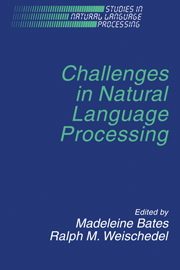Book contents
- Frontmatter
- Contents
- Preface
- Symposium participants
- Part I Challenging problems
- Part II Building a lexicon
- 2 The contribution of lexicography
- 3 The contribution of linguistics
- 4 The contribution of computational lexicography
- Part III Semantics and knowledge representation
- Part IV Discourse
- Part V Spoken language systems
- Part VI Conclusion
- Author index
- Subject index
4 - The contribution of computational lexicography
Published online by Cambridge University Press: 05 March 2010
- Frontmatter
- Contents
- Preface
- Symposium participants
- Part I Challenging problems
- Part II Building a lexicon
- 2 The contribution of lexicography
- 3 The contribution of linguistics
- 4 The contribution of computational lexicography
- Part III Semantics and knowledge representation
- Part IV Discourse
- Part V Spoken language systems
- Part VI Conclusion
- Author index
- Subject index
Summary
Introduction
This chapter presents an operational definition of computational lexicography, which is emerging as a discipline in its own right. In the context of one of its primary goals – facilitation of (semi-)automatic construction of lexical knowledge bases (aka computational lexicons) by extracting lexical data from on-line dictionaries – the concerns of dictionary analysis are related to those of lexical semantics. The chapter argues for a particular paradigm of lexicon construction, which relies crucially on having flexible access to fine-grained structural analyses of multiple dictionary sources. To this end, several related issues in computational lexicography are discussed in some detail.
In particular, the notion of structured dictionary representation is exemplified by looking at the wide range of functions encoded, both explicitly and implicitly, in the notations for dictionary entries. This allows the formulation of a framework for exploiting the lexical content of dictionary structure, in part encoded configurationally, for the purpose of streamlining the process of lexical acquisition.
A methodology for populating a lexical knowledge base with knowledge derived from existing lexical resources should not be in isolation from a theory of lexical semantics. Rather than promote any particular theory, however, we argue that without a theoretical framework the traditional methods of computational lexicography can hardly go further than highlighting the inadequacies of current dictionaries. We further argue that by reference to a theory that assumes a formal and rich model of the lexicon, dictionaries can be made to reveal – through guided analysis of highly structured isomorphs – a number of lexical semantic relations of relevance to natural language processing, which are only encoded implicitly and are distributed across the entire source.
Information
- Type
- Chapter
- Information
- Challenges in Natural Language Processing , pp. 99 - 132Publisher: Cambridge University PressPrint publication year: 1993
Accessibility standard: Unknown
Why this information is here
This section outlines the accessibility features of this content - including support for screen readers, full keyboard navigation and high-contrast display options. This may not be relevant for you.Accessibility Information
- 1
- Cited by
